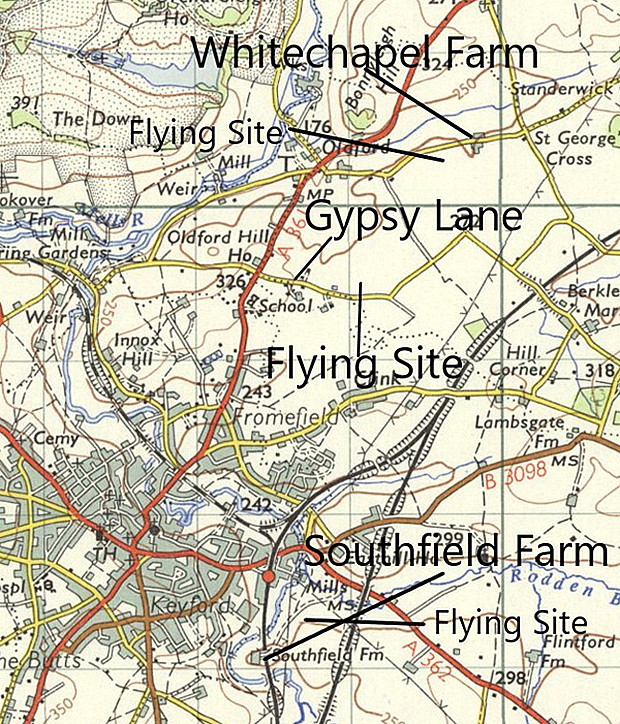Frome flying sites
Note: This map only gives the location of Frome town within the UK.
FROME see also GIPSY LANE
FROME see also SOUTHFIELD FARM
FROME see also WHITECHAPEL FARM
FROME: Temporary aerodromes
NOTES: Mike Holder, a great friend of this 'Guide', has been researching this area and has obtained much information plus providing maps, photos and articles. These will be listed seperately.
SOUTHFIELD FARM: Used by the Berkshire Aviation Co from 31st August to the 10th September 1920
WHITECHAPEL FARM: Used by Berkshire Aviation Tours from the 21st February until the 2nd March 1926
A site was used by CD Barnard Air Tours in/near Frome in May 1931 (Yet to be identified)
GIPSY LANE: On the 5th May 1932 Sir Alan Cobham’s National Aviation Day UK Display Tour performed in Frome.
FROME: Civil Landing Ground
Operated by: Mr James Griggs, Fones Grove, Standerwick
Location: “2.5m NE of Frome, just N of railway, S of Beckington village off Berkley Lane”
Period of operation: 1930s only?
Runway: Max landing run: 439 grass
NOTES: Info source ‘AA Landing Grounds’ publication, 1930s.
In 1933 the AA (Automobile Association) had approved 74 Landing Grounds and 75 Local Authority and private airfields were also registered with the Air Ministry.
When enquiring of the A.A. if I could inspect these registers of Landing Grounds several years ago I was informed that the A.A. had passed their records of these sites to a body which charges considerable amounts of money to view the files. However, I have since discovered several other sources.
OTHER INFO
More recent information indicates that this Landing Ground (in 1933 at least) had no hangars and the nearest telephone was at Fair Oak Farm, Berkley. Fuel and transport (typically a taxi service) could be ordered from Hobbs Motor Co Ltd, Market Place Garage or Yorks Motor Works, 24 Bath St, Frome.
Regarding fuel supplies I think that many readers may not appreciate that in those days aircraft engines were designed to run on the same types of fuel used by motor vehicles and this trend for British light aircraft continued after WW2 which made it readily available and relatively inexpensive.
THE FUEL DEBATE
In recent years many light aircraft, especially micro-lights, can run on Mogas, or petrol that modern cars use but the practise does have issues. It was largely the arrival of imported American light aircraft in considerable numbers during the 1960s which changed everything.
Their Continental and Lycoming engines required AVGAS 100LL (100 octane low-lead) and airfields and airports had to lay on dedicated supplies which, needless to say, meant a price hike and the disparity has stayed on.
For example, in October 2013 in London where I live, the average price for unleaded was £1.33 a litre and the UK average not much higher. By comparison a search for AVGAS prices in England revealed a wide range. For example the cheapest fuel I could find was at EGGESFORD (DEVON) at £1.44 a litre whereas the most expensive was HUMBERSIDE airport (LINCOLNSHIRE) at £3.24 a litre, over twice as much.
The main range was between £2.10 and £2.70 a litre. And of course these basically very old engine designs are very inefficient gas guzzlers. For example a well maintained and well flown Cessna 172 with a 160hp Lycoming, flying over a reasonable distance in the cruise and not climbing above say 2,500ft can be expected to have a fuel burn of about 7 Imperial gallons (31.5 litres) per hour cruising at 105 knots (120mph), or very roughly averaging 17mpg, if I’ve got the sums correct.
THE DIESEL MYTH
Incidentally, for people not too familiar with aviation matters, the appearance in more recent years of ‘diesel’ engines in propeller driven light aircraft is somewhat misleading in that although they are compression-ignition engines they do not run on diesel fuel but Jet A.1 used by jet engines which is more akin to paraffin.
Without any doubt they use less fuel than petrol powered equivalents but, having flown a couple of examples they do appear to manage to combine all the disadvantages of petrol and diesel engines whilst possessing none of the advantages of either.
But of course the vast majority of pilots have not had the experience, as I have had, of driving the latest and largest trucks with astonishingly powerful and incredibly efficient low-revving diesel engines. This said they might well own a diesel car and, if so, this should provide a worthwhile comparison.
To be fair, although the Germans had diesel engines fitted to aircraft prior to WW2, the manufacturers of diesel aircraft engines have nothing even remotely resembling the resources that car, bus and truck manufacturers have and I sincerely hope they succeed eventually. If only for eliminating the possibility of carb-icing - which of course does not occur in fuel-injected petrol engines.
We'd love to hear from you, so please scroll down to leave a comment!
Leave a comment ...
Copyright (c) UK Airfield Guide
















